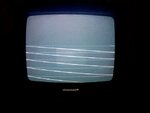Fagenhauser
Newbie level 3
I have a Panasonic TC14-S4RC CRT TV that has a fluctuating brightness. It also shows about 10 bright diagonal retrace lines on an otherwise grey display. Tapping the PCB causes changes in the brightness but also without tapping the brightness changes. When the brightness becomes too high the tv switches off. I disconnected the control circuit that goes to a pin on the microcontroller called ABL. With this line disconnected tapping the PCB still causes brightness to change but the tv is not switched off anymore. All bias voltages seem alright. Could it be the heater, how can I check this? Could a dried up elco cause this problem, could tapping change capacitance or is a microcrack in a PCB-trace more likely? I only used a DMM so far. Many thanks for any suggestions that would help fix this problem.
